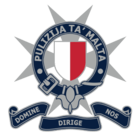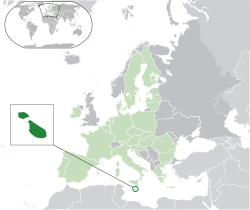The Malta Police Force
The Malta Police Force (Maltese: Il-Korp tal-Pulizija ta’ Malta) is the national police force of Malta. It falls under the responsibility of the Ministry for Home Affairs and National Security and its objectives are set out in The Police Act, Chapter 164[3] of the Laws of Malta. Presently, the force is made up of around 2,400 members.
| The Malta Police Force Il-Korp tal-Pulizija ta’ Malta | |
|---|---|
 Malta Police Force Logo | |
 Official Insignia | |
| Common name | Il-Pulizija |
| Motto | Domine Dirige Nos Lord Guide Us |
| Agency overview | |
| Formed | 12 July, 1814 |
| Annual budget | €76,420,000 (2020)[1] |
| Jurisdictional structure | |
| National agency (Operations jurisdiction) | Malta |
| Operations jurisdiction | Malta |
 | |
| Map of The Malta Police Force's jurisdiction. | |
| Size | 316 km² |
| Population | 475,700[2] |
| Legal jurisdiction | As per operations jurisdiction |
| General nature | |
| Operational structure | |
| Headquarters | Police General Headquarters, Pjazza San Kalcidonju, Floriana FRN 1530, Malta |
| Police Officers | 2,300 (2018) |
| Civilians | 102 (2018) |
| Minister responsible |
|
| Agency executives |
|
| Parent agency | Ministry for Home Affairs, National Security & Law Enforcement |
| Notables | |
| Anniversary |
|
| Website | |
| pulizija | |
| Emergency Telephone Number 112 Crime Stop Line 119 | |
Organisation
The Malta Police Force holds mixed responsibilities in investigative and national security issues. It is always in search of the truth within the parameters of its investigative powers, combined with those afforded by the judicial authority.

The role of a police officer is multifaceted. It includes the preservation of public order and peace; the prevention, detection and investigation of offences; and the collection of evidence against offenders.[4]
The Force operates the following specialised branches:
- Administrative Law Enforcement Unit
- Criminal Investigation Department
- Drug Squad
- Financial Crimes Units
- Protective Services
- Rapid Intervention Unit
- Special Branch
- Special Intervention Unit
- Vice Squad

Furthermore, a department known as the International Relations Unit (IRU) coordinates activities with EUROPOL, INTERPOL (since 1971) and the Schengen Information System, and is tasked with exchange of information.
History
The Malta Police Force in its present form dates from a proclamation during the governorship of Sir Thomas Maitland (1813-1814). When Malta became a crown colony of the United Kingdom of Great Britain and Ireland by the Treaty of Paris, Maitland was appointed Governor and commander-in-chief of Malta and its dependencies by the Prince Regent's Commission of 23 July 1813. On his appointment Maitland, embarked on many far reaching reforms, including the maintenance of Law and Order.
By Proclamation XXII of 1 July 1814, Maitland ordered and directed that all powers up to then exercised with respect to the administration of the police of the island of Malta and its dependencies were, after 12 July 1814 to be administered by the authorities under established procedures.
The police was to be divided into two distinct departments - the executive police and the judicial. The inspector general of police (Nowadays The Commissioner of Police) was to be the head of the executive police. The Magistrates for Malta and the Magistrates of Police for Gozo were to be the heads of the judicial police.
From 12 July 1814 onwards, the entire management and control of the executive police came under the immediate superintendence of the inspector general of police who received his orders from the governor.
After the grant of self-government in 1921, the police department became the responsibility of the Maltese government. The first minister appointed, who was responsible for justice and the police, was Dr Alfredo Caruana Gatto.[5]
General headquarters
The Police Depot, as it is known today, was built by the Portuguese Grand Master Manoel De Vilhena in 1734 and at first it served as an institute called Casa D’Industria, a home for homeless women. They were taught basic skills and education such as reading, writing and some trades like weaving, carding and processing cotton.
In 1850, during the British occupation period, this building was used as the General Hospital. Beneath this building, a shelter was dug at the beginning of the Second World War in order to tend to wounded patients who could not be easily moved from one place to another. This space therefore provided a safer environment for patients during air bombardments. Imagine what would have happened if during an operation, doctors would have to stop from their medical intervention on patients. That is why there are two operating theatres in this shelter. It is interesting to note that this is not only the only shelter in the Maltese Islands used for this function, because as far as we know, there is no underground hospital on the continent that was built or dug out to operate in this way.
It was in 1954 that the Police Force moved into this building and turned it into its General Headquarters, from where it still operates today.[6]
Police museum
The Museum is divided into two sections: each section is housed in a separate hall. The first section deals with the administrative history of the force and the second part is about some of the criminal cases.
In the first hall, one will see various objects and belongings, for example uniforms, badges, medals, decorations, weapons and many other interesting things including tools and vehicles which were all required and used in different periods which helped the Police Force to carry out its duty to the best of its ability.
In the second hall one can see made-up scenes of crime that happened in Malta.[7]
Mission and vision

- Mission: To Promote and maintain Malta as a safe and secure state.
- Vision: To enhance public respect, pride and confidence by distinguishing itself in its strategies, actions and behaviors, as a dedicated, professional, honest and responsible Police Force.[8]
Police Commissioners
- Col Francesco Rivarola (1814-1822)
- Lt Col Henry Balneavis (1822-1832)
- Charles Godfrey (1832-1844)
- Frederick Sedley (1845-1858)
- Hector Zimelli (1858-1869)
- Raffaele Bonello (1869-1880)
- Col Attillo Sceberras (1880-1884)
- Capt. Richard Casolani, RMFA (1884-1888)
- Melitone Caruana (1888-1890)
- Comm. Hon. Clement La Primaudaye, MVO., RN (1890-1903)
- Tancred Curmi (1903-1915)
- Claude W. Duncan (1916-1919)
- Col Henry W. Bamford, OBE (1919-1922)
- Antonio Busuttil (1922-1923)
- Mjr Frank Stivala (1923-1928)
- Lt Col Gustavus S. Brander, OBE (1930-1932)
- Joseph Axisa (1939-1947)
- Joseph Ullo (1947-1951)
- Herbert Grech (1951-1954)
- George Cachia, L.P. (1954-1956)
- Vivian Byres de Gray, MVO., MBE., BEM (1956-1971)
- Comm. Alfred J. Bencini (1971-1973)
- Edward Bencini (1973-1974)
- Enoch Tonna (1974-1977)
- John N. Cachia (1977-1980)
- Dr Lawrence Pullicino, LL.D. (1980-1987)
- Bgdr. John Spiteri, AFM (1987-1988)
- Alfred A. Calleja (1988-1992)
- George Grech (1992-2001)
- John Rizzo (2001-2013)
- Peter Paul Zammit, L.P. (2013-2014)
- Michael Cassar (2014-2016)
- Lawrence Cutajar (2016-2020)[9]
- Carmelo Magri (Acting) (2020)
- Angelo Gafa (2020-)
References
| Wikimedia Commons has media related to Law enforcement in Malta. |
- "The Budget Speech 2020" (PDF). mfin.gov.mt.
- "Eurostat: Population on 1 January" (PDF). Eurostat. 14 June 2018.
- "The Police Act, Chapter 164". www.justiceservices.gov.mt. Retrieved 18 September 2018.
- "Malta Police Force". www.gov.mt. Retrieved 18 September 2018.
- "History of the Malta Police". pulizija.gov.mt. Retrieved 18 September 2018.
- "Police Museum". pulizija.gov.mt. Retrieved 18 September 2018.
- "Police Museum". pulizija.gov.mt. Retrieved 18 September 2018.
- "Malta Police Force Code Of Ethics" (PDF). pulizija.gov.mt. Retrieved 18 September 2018.
- "Police commissioner Lawrence Cutajar resigns".